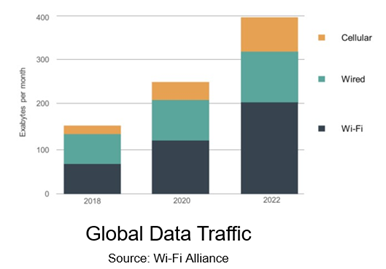Wi-Fi 7 May Be Closer Than You ThinkWi-Fi 7 May Be Closer Than You Think
Wi-Fi 7 products, due out in 2024, will offer significantly more performance for enterprise users and can support more users in denser environments compared to Wi-Fi 6.
September 11, 2023

Last year, Intel and Broadcom carried out the first cross-vendor Wi-Fi 7 cross-vendor demonstration, where an Intel-based laptop with Wi-Fi 7 connected to a Broadcom Wi-Fi 7 access point. And this summer, EnGenius Technologies launched what it claims to be the first cloud Wi-Fi 7 access points for the enterprise.
While the company (EnGenius) says it will have products available later this year, many in the industry are looking to 2024 as the year we will start seeing new standards-based and Wi-Fi Alliance-certified Wi-Fi 7 products hit the market. Even at that, given the time it takes to evaluate and purchase IT products, now might be the right time for enterprises to start looking at Wi-Fi 7.
Why the interest in Wi-Fi 7? After all, Wi-Fi 6 and Wi-Fi 6E, which both brought improved performance and higher maximum throughputs, are relatively new to the market. Standards-based enterprise gear for each has only been widely available in the last several years.
The main appeal of Wi-Fi 7 is that many of the performance enhancements and other improvements that Wi-Fi 6 made available are simply greater with Wi-Fi 7.
What's driving the need for higher-performance Wi-Fi?
The amount of traffic being carried over Wi-Fi networks has roughly quadrupled in four years. In contrast, traffic over wired networks has only grown modestly during that same period.

wi-fi-stat.png
There are more bandwidth-intensive applications in use by enterprise users all the time. A comment made during a recent Network Computing editorial webinar anecdotally bolstered this point. To wit, one of the participants noted in framing a question: “Before the pandemic, I would say 90% to 95% of my conference calls were dial-up phone calls. After the pandemic, I've not made a single phone call. Everything is Zoom, WebEx, and Teams meetings, no matter what, even if it could be done with a phone call. Is that what others are seeing?”
Why is any of this a problem? As the number of users grows and traffic increases, performance issues arise. Contention for the limited bandwidth diminishes bandwidth for each user, increases latency, and introduces jitter. All these issues particularly impact modern applications that rely on streaming data and video. Users need more bandwidth and better responsiveness for their apps.
Wi-Fi 6 and 6E try to address these needs. One differentiator with Wi-Fi 6 over Wi-Fi 5 is that devices can make use of a 2.4 GHz spectrum band (in addition to the 5 GHz bands supported in previous generation devices) for added capacity. Additionally, Wi-Fi 6 supports traffic prioritization, beamforming, and orthogonal frequency division multiple access (OFDMA) to improve performance. For example, OFDMA improves performance in dense environments by allowing a mix of smaller packets along with the larger packets that might be used for streaming of video. That provides a deterministic, consistent experience on a network.
Another factor is that Wi-Fi 6E-enabled devices can use an additional 1200 MHz of spectrum in an unlicensed 6 GHz band.
Currently, there is great interest in Wi-Fi 6 and 6E, according to the most recent Network Computing Network Management Survey. The survey found that of the 336 IT manager respondents, 21% have purchased Wi-Fi 6 and 6E equipment, 13% plan to in the next 12 months, and 23% are evaluating it.
Those numbers include a mix of all types of equipment (endpoint devices, routers, access points, etc.). Perhaps a better indicator of the importance of the technology in the enterprise is that 40% said they plan to purchase Wi-Fi 6 and 6E access points in the next year.
Others also see a strong demand for 6th generation Wi-Fi. IDC predicts that two-thirds of Wi-Fi shipments this year will be Wi-Fi 6 or Wi-Fi 6E. And IDC expects more growth in years to come. “There is all growth going forward layered with trends of more Wi-Fi 6 and 6E devices coming into play, Wi-Fi 7 chips ramping up in higher-end devices and access points, and more discrete Wi-Fi solutions in primary client devices and other product types,” said Phil Solis, research director, Connectivity and Smartphone Semiconductors at IDC, in a released statement.
Enter Wi-Fi 7
Wi-Fi 7 will offer significantly more performance for enterprise users and can support more users in denser environments compared to Wi-Fi 6. “We are looking at a 4.8 times connection speed gain from Wi-Fi 6, making the maximum theoretical data rate 46 Gpbs,” says Xiang Li, Industry Solution Marketing Engineer at Keysight Technologies. “Additionally, Wi-Fi 7 will deliver less than 5 milliseconds of latency. That is over 100 times better than Wi-Fi 6.” Li also notes that the network capacity of Wi-Fi 7 will be five times that of Wi-Fi 6.
Such performance improvements make Wi-Fi 7 ideal for streaming applications and for reducing congestion in crowded environments. So, more users can run more bandwidth-intensive and latency-dependent applications without incurring performance problems. Looking at it in another way, an enterprise can support more users with fewer access points. That translates into lower management costs.
The performance improvements of Wi-Fi 7 will be due to several factors.
First, Wi-Fi 7 routers, access points, and devices will likely make full use of the 6 GHz band of spectrum that became available with Wi-Fi 6E.
These same devices will incorporate new technologies, including automated frequency coordination, multi-link operations, and 4K Quadrature Amplitude Modulation (4K QAM). These technologies squeeze more capacity out of a wireless network, reduce latency, and make Wi-Fi networks more responsive, what some like to say will be wired-like responsiveness.
Related articles:
About the Author
You May Also Like




